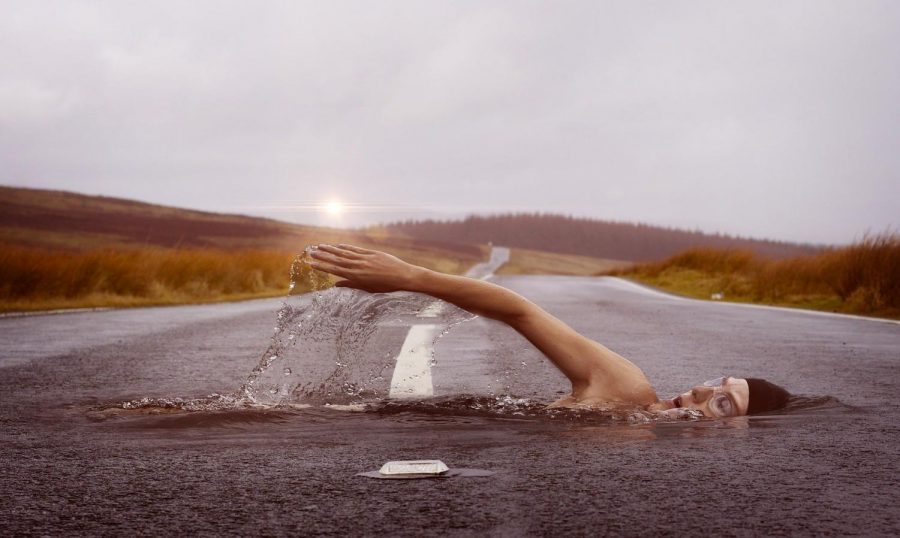Nature Is Our Home: A Call to Action
A Dystopian Image Depicting the Ravages Inflicted on Our Environment That Humans Seems to Ignore
April 13, 2020
Humans take advantage of a lot – food, water, but more importantly, the whole planet. Our terrible treatment of the only planet we have to live on has an undeniable impact. Since 1970, humans have killed 60% of all species according to The Guardian. The reason for this biological destruction is expansion. The human population is growing 7,000 times faster than it did in 1800, according to the Delaware Museum of Natural History. We have been adding around one billion people to our planet every 10 years since 2000. If this trend continues, the majority of the planet’s biodiversity will disappear; the fate of animals is inexorably linked to that of humans. We can’t destroy these animals and habitats. Doing so would be destroying ourselves.
Since the beginning of our time on Earth, humans have depended on animals. Whether for food, clothing, or comfort, animals have been a large part of our larger human society. Today, however, we cut down entire forests in minutes that house animals and species that are crucial to our well being. In fact, about 45 million acres worldwide of forests are lost every year to people cutting down trees, according to the World Wildlife Fund. From when humans originated in the Great Rift Valley in Ethiopia, to today, a shocking 83% of all mammals, and 50% of all plant species, have disappeared, according to The Guardian. Poof. Eliminated. On and on we go, taking out animal after animal, species after species, forest after forest, until only 40% of all life is left. Simply put, we came, we saw, we conquered.
The main reason for animal extinction is human encroachment on their habitats. According to the World Economic Forum, humans will have taken over 460,000 square miles of land for cities by 2050. That would be devastating for the hundreds of thousands of animals on the edge of extinction. A local example of the phenomenon is the city of Middletown, Delaware. The Middletown Census of 2010 shows the city went from 6,000 people to 18,000 people in 10 years, drastically transforming the landscape around it.
Humans are growing fast. As houses, businesses, stores, and so much more are shoved into our environment to compensate for the influx of humans, animals are dying at an alarming rate. This happens in Delaware also, especially Delaware’s wetlands, a biome common to Delaware. They are wet in the spring, and, by the end of the summer, they completely dry up. That indicates that, since only amphibians can survive year-round in the wetlands, there are no predators for them there; truly, they have a chance of greater survival. But, we move right in with human developments, endangering the lives of those amphibians. We are morphing our natural land into high rises, business centers, malls, etc. The list goes on and on, eliminating the ability for animals to live anywhere near cities.
Such expansion has a price: the health of countless humans. John Muir famously said, “When we try to pick out anything by itself, we find it hitched to everything else in the universe.” So, when animals die, that makes everything that benefits from it die eventually as well. Trees that rely on the animals inhabiting them die and take with them the ability to clear the air of CO2, for example. Our health is directly tied to nature. Our natural environment provides so many necessities to us – from our food and water, to the prevention of natural disasters, to the regulation of climate change. Humans rely on our surroundings so much, that we will evidently suffer if we eliminate its natural productions. Many scientists are worried about this issue of human interference in the environment, stating, “this is actually now jeopardizing the future of people. Nature is not ‘a nice to have’—it is our life support system,” said Mike Barrett, executive director of science and conservation at the World Wildlife Fund.
It doesn’t have to be this way, though. There are many steps that we can take to bring animals back from the brink of extinction and keep our nature thriving. Cities are planting fruit trees and nest boxes and converting old structures into animal-friendly spaces. Many green roofs have sprung up in cities around the globe. Cities in Australia are doing so well, a sewage plant has become a “hotspot for birdwatchers.” Ms.Mckinelly, WFS ninth grade physics teacher commented that “One of the best things you can do though is plant native plants. They provide the best ecosystem for native animals.” Ms.Mckinelly makes a compelling point: animals thrive in their ecosystems, and if there are more animals, predators have more to eat, and the food chain can remain stable. But, the biggest thing we can do is reduce. If we use less and have less, we will impact the environment less.
Nature is our home; it has and will always be. The way we are progressing is indicative of its potential destruction. We can still turn the tables and fix this, though, if we act quickly. If not, well, the results will be disastrous.
































Miranda • Apr 20, 2020 at 3:18 pm
Insightful and a call to action. Thank you, Collier for making such a strong argument to care for our fellow beings!